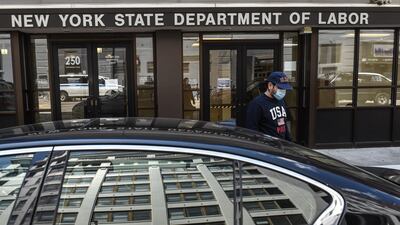In the harshest downturn for American workers in US history, employers cut an unprecedented 20.5 million jobs in April and the unemployment rate more than tripled to 14.7 per cent.
Back in February, before the coronavirus pandemic brought the US economy to a standstill, the rate hovered at just 3.5 per cent. That had been the lowest level in five decades. April’s data is the highest since just after the Great Depression of the 1930s.
April’s losses erase roughly all of the jobs that the economy had added in this past decade’s expansion and lay bare just how precarious employment is for vast swaths of Americans.
The US Labour Department said the unadjusted unemployment rate iwould have been almost 5 percentage points higher had workers been classified as unemployed on temporary lay-off, rather than employed but absent from work due to other reasons.
Furloughed workers accounted for about four out of every five unemployed Americans.
With a steep recession now in progress, the destruction of jobs heaps election-year pressure on President Donald Trump to restart the economy and show results by November.
But with little containment of a contagious disease that’s killed 75,000 Americans and counting, business is returning unevenly and slowly if at all, and signs are mounting that many employers will be forced to make the cuts permanent.
Mr Trump said on Friday that the massive US job losses from the coronavirus outbreak aren’t a surprise and that he shouldn’t be blamed for it.
“It’s totally expected, there’s no surprise,” he said on Fox News Channel, where he was being interviewed as the report was released. “Even the Democrats aren’t blaming me for that. What I can do is I can bring it back.”
In the minutes after the report, the Bloomberg dollar index pared its decline for the day while the yield on benchmark ten-year treasuries rose to its highs of the session after the report.

However, the American equity futures rose as investors looked past unprecedented job losses and focused on the latest steps toward lifting coronavirus restrictions and US-China trade developments.
S&P 500 futures pointed to a positive start on Wall Street after news that China and the US had a constructive phone call on trade.
“The jobs report marks a sobering moment in our history, while also likely marks the bottom of the economic contraction with hope for a better remainder of the year,” said Bryce Doty, senior portfolio manager at Sit Fixed Income Advisors.
Average hourly earnings rose 4.7 per cent from the prior month and 7.9 per cent from a year earlier, skewed higher by the disproportionate loss of low-wage workers from payrolls - rather than any wage pressures boosting employee pay.
The underemployment rate, which includes discouraged workers and those working part-time who want full hours, rose to 22.8 per cent from 8.7 per cent.
Almost every industry was hit hard. Leisure and hospitality employers cut 7.65 million, manufacturers cut 1.33 million positions and retailers 2.1 million. Even healthcare jobs fell by 1.44 million as non-Covid visits and elective procedures dried up or offices closed.
The job losses may also fan calls for a fourth round of fiscal aid from Congress on top of trillions of dollars already dispatched, even with signs many Americans are having difficulty tapping the funds.

The Federal Reserve is likely to keep pumping money into the economy while leaving interest rates near zero for an extended period.
While the pandemic has crushed economies around the world, job losses hurt more in the US than in most other developed nations.
That’s because about 160 million Americans get health insurance through employers, and without jobs, they could face steep monthly premiums or lose coverage entirely, which may exacerbate the economic impact of the coronavirus.

